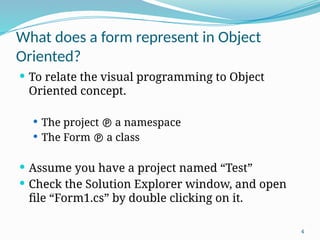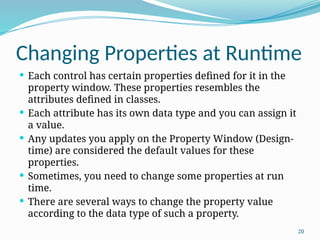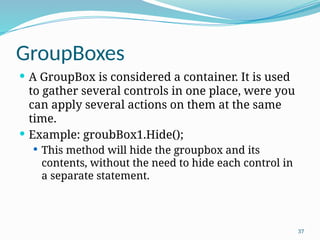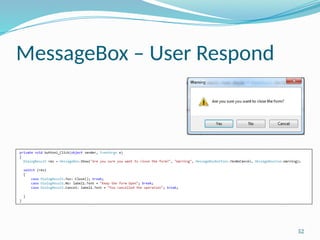Ad
Visual programming Chapter 3: GUI (Graphical User Interface)
- 1. Visual programming Chapter 3: GUI (Graphical User Interface) Part I Eman Alnaji Dareen Hamoudeh
- 2. 2 Contents Form Buttons Labels TextBoxes GroupBoxes Panels CheckBoxes RadioButtons Font Class MessageBox PictureBox
- 3. 3 Form The form is the most important element in a Visual C# Project, since it is the interface (window) that the user interacts with. When you first create your project, form1, is always created at the beginning, meaning that you can’t have a project without a form.
- 4. 4 What does a form represent in Object Oriented? To relate the visual programming to Object Oriented concept. The project a namespace The Form a class Assume you have a project named “Test” Check the Solution Explorer window, and open file “Form1.cs” by double clicking on it.
- 5. 5 What does a form represent in Object Oriented? Project Name Form Name Form1 Constructor This method is pre- defined to set the initial values of all controls’ properties in the form. What does a Partial modifier mean? Note here, that Form1 is inherited from a pre-defined class “Form”
- 6. 6 Partial Modifier The Partial Modifier is used to be able to define the same class in several files. This file “form1.cs”, is used by the developer to add his/her own code and event handlers. And Form1 class is defined partially, so where is the rest of this class?
- 7. 7 Partial Modifier Return back to the Solution Explorer, and double click the file “form1.Designer.cs”. Check here, that the Form1 class is re-defined again in this file, which is not possible unless you use the modifier Partial.
- 8. 8 Form1.Designer.cs Why this file is created? And who created it? This file is automatically created by Visual C#, to contain all definitions of all controls added to the form. We will discuss this shortly.
- 9. 9 Form: Properties Text: The title of the form BackColor: The background color of the form. ForeColor: The color of the font of any control added to the form. Font: The style of the font of any control added to the form. Size: Determines the width and height of the form. Maximum Size: Determines the maximum width and the maximum height of the form the user can reach at run time. Minimum Size: Determines the minimum width and the minimum height of the form the user can reach at run time. To change any of these properties, you can relate to it by using the keyword “This”, or directly. (since you are dealing with a class here).
- 10. 10 Form: Default Event Load: This event occurs at the beginning of the execution of the project (i.e. when the form is loaded)
- 11. 11 Form: Method Close(); This method closes the form.
- 12. 12 Buttons A Button, is a very common control that you may find in any program works under Windows. To add a Button, or any control we will discuss later, go to the toolbox, then: Either, double click on it, then it will appear to a default location on the form. Or, drag it from the Toolbox and drag it on the form to the location you desire.
- 13. 13 A Button in Form1.Designer.cs File When you add a button, or any control, to your form, you actually instantiate an object of a related class. Meaning button1 is actually an object of a pre- defined class named Button. The code needed for this instantiation will be automatically generated in Form1.Designer.cs file by the visual C#, as soon as you add the button.
- 14. 14 A Button in Form1.Designer.cs File This leads us to the reason why Form1 class is divided into these two files. Form1.Designer.cs to be used mainly by the visual C#, and Form1.cs is to be used by the developer (YOU!). And of course all controls that we will discuss later are added in the same way.
- 15. 15 Button: Properties Text: The label on the button. Name: The name of the object (ex: button1) This name is used in the code when referring to the object. Size: Width and height of the button. Location: the coordinates X and Y on the form, where the button resides.
- 16. 16 Button: Properties Enabled: True a control can be accessed by the user False a control cannot be accessed by the user. Visible: True a control is displayed on the form False a control is hidden from the form. Important Note: The previous properties apply on almost all controls, and are handled in the same way.
- 17. 17 LABELs A Label is an un-editable text that is added to the form, to display a certain message or a hint about a control. Usually, the label takes the size of the text written in it and the font size, unless the “autosize” property is set to false.
- 18. 18 Label: Properties Text: The string displayed by the label. Autosize: True the label takes the size of the text written in it. False you can resize the label as you like in the design time. TextAlign Changes the alignment of the text within the borders of the label. It works properly when the Autosize property is set to False.
- 19. 19 Show and Hide Methods Show() Hide() These two methods are almost available for all controls along with the form itself. If you need to hide a button for example, you write: button1.Hide(); To show it again: button1.Show(); These two methods actually change the value of the Visible property in the desired control.
- 20. 20 Changing Properties at Runtime Each control has certain properties defined for it in the property window. These properties resembles the attributes defined in classes. Each attribute has its own data type and you can assign it a value. Any updates you apply on the Property Window (Design- time) are considered the default values for these properties. Sometimes, you need to change some properties at run time. There are several ways to change the property value according to the data type of such a property.
- 21. 21 How to determine a data type for a property? When you need to change a certain property for a certain control (i.e. assign a new value to it), you need to write an assignment statement starting with this property. Suppose you need to change the text property of a label, you will start the assignment statement as: label1.Text = Now you need to figure out the data type of this property, just hover the mouse over this property (in the code), and a tooltip will be displayed to give you a hint about it.
- 22. 22 How to determine a data type for a property? To find out the data type of property Text: From the above picture, you can find out that the Text data type is string.
- 23. 23 Changing Properties (Basic Data Types) To change the value of a property that have a basic data type (int, float, double, decimal, string, char, ..etc.), you can use a simple assignment statement to provide the value you need. Ex: label1.Text = “Hello World”; // assign a direct value Or this.Text = label1.Text; //changes the title of the form with the Text value in the label Note: Just make sure that you are assigning the right data type to the property, or you need to convert it if applicable. Ex: label1.Text = 215 + “”; //here you will add 215 to the text, but after converting it to a string.
- 24. 24 Changing Properties (pre-defined enumeration) Some properties have pre-defined data types (enumerations) with several values, so you need to use these values to change them. Example, the backColor property. Note here that BackColor is of data type “Color”, this is not a basic data type, so you will have to use it to change the property value.
- 25. 25 Changing Properties (pre-defined enumeration) When using Color. a list of all valid values will appear so that you can select from them.
- 26. 26 Changing Properties (Composite Properties) Some properties consist of other several properties, such as Font (Name, Size, Style) Size (width, height) Location (X, Y) So, to change these properties, or properties they consist of, we have to instantiate an object of the class related to this property.
- 27. 27 Changing Properties (Composite Properties) Example: To change the property of a label font. In this code, you can change the three composite properties of the font. Here you change the font name to “Arial”, the font size to 16 and the style to Bold. Of course you can change only one of them, by remaining the others as they are set in the Properties Window. This will be discussed Later.
- 28. 28 TextBoxes A TextBox is an editable control that is mainly used to enable the user to enter data using keyboard.
- 29. 29 TextBox: Properties Text Multiline: If true, you can use Enter and add several lines to the textBox ScrollBars: In case of Multiline Textboxes, vertical and horizontal scrollbars can be displayed. WordWrap: True The lines won’t exceed the borders of the textbox. False you can continue writing in the line until you press Enter. This property only works when Multiline is activated.
- 30. 30 TextBox: Properties Forecolor: The color of the text inside. Readonly: when True, the user cannot write in the textbox, but can access it and copy its contents. Enabled PasswordChar: takes a single character as a value, and this character will be used to mask the entry in the textbox (password behavior) UseSystemPasswordChar: If True it masks the value in PasswordChar, and uses the password character used by Windows on the current PC.
- 31. 31 TextBox: Properties TabIndex: an integer used to order the navigation between controls, starting from smaller values to larger ones.
- 32. 32 TextBox: Default Even TextChanged: This event takes place when the user writes or deletes any character in the textbox.
- 33. 33 Convert Take into consideration that Text in a TextBox is a string. So whenever you need to use it for numbers, you will have to convert the string. And whenever you need to assign a numeric value to a textbox, you will have to convert it to string.
- 34. 34 Convert from String to Numeric Value In the statement below, a syntax error appears, because you are trying to assign a string into an integer. To convert a string into a numeric value:
- 35. 35 Convert from a numeric value into a string We have several ways to convert into a string:
- 36. 36 TextBox: Method Clear(): This method is used to clear any text in the textbox.
- 37. 37 GroupBoxes A GroupBox is considered a container. It is used to gather several controls in one place, were you can apply several actions on them at the same time. Example: groubBox1.Hide(); This method will hide the groupbox and its contents, without the need to hide each control in a separate statement.
- 38. 38 GroupBox: Properties Text: The caption appears at the top of a GroupBox
- 39. 39 Panels A Panel is another type of containers, that is used mainly as the groupbox, but it has extra properties that don’t exist in a groupbox.
- 40. 40 Panel: Properties BorderStyle: Can be (None, FixedSingle, Fixed3D) AutoScroll: if True, the scrollbars will appear if the controls inside the panel exceed its borders.
- 41. 41 CheckBoxes CheckBoxes are used to give several options to a user to check or uncheck. The user can select only one or several of them, or can unselect all of them.
- 42. 42 CheckBox: Properties Text Checked: True False CheckState: Checked UnChecked Indeterminate
- 43. 43 CheckBox: Default Event CheckedChanged This event takes place whenever the Checked Property is changed either to True or False.
- 44. 44 RadioButton: Properties/Default Event Properties: Checked True False Default Event CheckedChanged: Takes place when the checked property is changed to True or False.
- 45. 45 RadioButtons RadioButtons are used to give several options to user, but the user have to choose only one of each group. To separate several radiobuttons into several groups, we can use any of the containers in Visual C#, such as: GroupBox, Panel and the Form itself.
- 46. 46 Font Classs To change the font of a certain control, for example a label or a textbox, we instantiate an object from Font Class, and send the new values of (FontName, FontSize and FontStyle). But, in this statement, we change all the 3 values at the same time.
- 47. 47 Font Class - Cont. To change the style alone, for example, we remain the other values as defined. But, in the previous statement, the FontStyle is changed into Bold, regardless of the style that already is applied to the label.
- 48. 48 Font Class - Cont. To change the FontStyle while reserving the current style, we will use the XOR operator (^), as in the following example:
- 49. 49 Font Class - Cont.
- 50. 50 MessageBox To show a message dialog to the user, we will use MessageBox class along with the method Show(). MessageBox.Show() method is overloaded into several methods, but we will use in this course the following method, to display the following message: In this method, we send the message text, the message title, number and types of buttons to be displayed, and the icon.
- 51. 51 MessageBox – User Respond In the previous example, we only show a message, and don’t handle the respond of the user (i.e. whither the user clicked OK or CANCEL). To handle the user respond, we need to define a variable of type DialogResult, as in the following example
- 52. 52 MessageBox – User Respond
- 53. 53 PictureBox and Properties A PictureBox is used to display an image to the user. Properties: Image: where the selected image file resides. You can import an image from your PC.
- 54. 54 PictureBox: Properties SizeMode: Determines how the image is displayed in the pictureBox. Normal: Displays the topleft corner of the original image, according to the size of the picurebox. StretchImage: Changes the ratios of the original image to fit exactly in the pictureBox. AutoSize: changes the size of the PictureBox, according to the size of the original image. CenterImage: crops a part of the original image from its center according to the size of the PictureBox. Zoom: Changes the size of the original image, to fit in the PictureBox, but with reserving the ratios of the image.
- 55. 55 PictureBox – Default Event and Method Default Event: Click: occurs when the user clicks on the image using mouse. Method: FromFile: This method is used to change the displayed image at runtime. Important Note: Make sure to write the path in a correct way, so that the program can find the actual file. Also, make sure to write the correct extension of the image.
- 56. 56 The End






















































































































